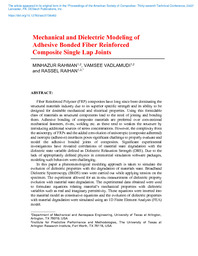
ATTENTION: The works hosted here are being migrated to a new repository that will consolidate resources, improve discoverability, and better show UTA's research impact on the global community. We will update authors as the migration progresses. Please see MavMatrix for more information.
Show simple item record
| dc.contributor.author | Rahman, Minhazur | |
| dc.contributor.author | Vadlamudi, Vamsee | |
| dc.contributor.author | Raihan, Rassel | |
| dc.date.accessioned | 2022-10-28T17:20:33Z | |
| dc.date.available | 2022-10-28T17:20:33Z | |
| dc.date.issued | 2022 | |
| dc.identifier.uri | http://hdl.handle.net/10106/31000 | |
| dc.description | RAHMAN, M., VADLAMUDI, V., & RAIHAN, R. (2022). Mechanical and Dielectric Modeling of Adhesive Bonded Fiber Reinforced Composite Single Lap Joints. In PROCEEDINGS OF THE AMERICAN SOCIETY FOR COMPOSITES-THIRTY-SEVENTH TECHNICAL CONFERENCE. | en_US |
| dc.description.abstract | **Please note that the full text is embargoed** ABSTRACT: Fiber Reinforced Polymer (FRP) composites have long since been dominating the structural materials industry due to its superior specific strength and its ability to be designed for desirable mechanical and electrical properties. Using this formidable class of materials as structural components lead to the need of joining and bonding them. Adhesive bonding of composite materials are preferred over conventional mechanical fasteners, rivets, welding etc. as these tend to weaken the structure by introducing additional sources of stress concentrations. However, the complexity from the anisotropy of FRPs and the added convolution of anisotropic (composite adherend) and isotropic (adhesive) interfaces poses significant challenge to properly evaluate and model the adhesive bonded joints of composites. Significant experimental investigations have revealed correlations of material state degradation with the dielectric state variable defined as Dielectric Relaxation Strength (DRS). Due to the lack of appropriately defined physics in commercial simulation software packages, modeling such behaviors were challenging. In this paper a phenomenological modeling approach is taken to simulate the evolution of dielectric properties with the degradation of materials state. Broadband Dielectric Spectroscopy (BbDS) tests were carried out while applying tension on the
specimen. The experiment allowed for an in-situ measurement of dielectric property evolution with material state degradation. The experimental data obtained were used to formulate equations relating material’s mechanical properties with dielectric variables such as real and imaginary permittivity. These equations were inserted into
the material model as constitutive equations and the evolution of dielectric properties with material degradation were simulated using an 1D Finite Element Analysis (FEA) model. [ https://doi.org/10.12783/asc37/36462] | en_US |
| dc.language.iso | en_US | en_US |
| dc.publisher | Proceedings of The American Society for Composites-Thirty-seventh Technical Conference | en_US |
| dc.title | Mechanical and Dielectric Modeling of Adhesive Bonded Fiber Reinforced Composite Single Lap Joints | en_US |
| dc.type | Article | en_US |
Files in this item
- Name:
- 5. Rahman_ASC.pdf
- Size:
- 1.515Mb
- Format:
- PDF
- Description:
- PDF
This item appears in the following Collection(s)
Show simple item record


